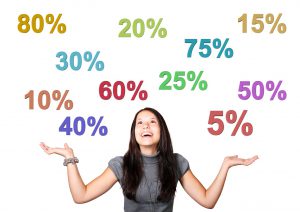Here’s a bit of a riddle: how can overspending look like saving money? When stores use the language and psychology of discounts to get us to open our wallets when we might not have otherwise made a purchase. Discounts, coupons, bulk buys – they can all be utilized by stores to make us think we’re getting a great deal, when in reality, seeing those clearance signs and 25% off stickers might be luring us into spending extra money. Sure, getting something you need at a better price is great, and we’re all for it, but make sure you’re being wise with your money, no matter how unmissable that sale seems! Here are some of the tricks stores use, some sales that are missable, and a few ideas for making discounts work for you.

No Doubt About It, Stores Have Got Our Number!
What are two things we can say for sure about stores, advertisers, and marketers? They’ve spent a lot of time researching the psychology of spending and studying our shopping habits, and they don’t offer discounts out of the goodness of their hearts. They want you to buy things, and the more, the better! To achieve that end, they take advantage of certain tactics, including:
- The “coupon high” – It seems silly when we stop and think about it, but shopping – and specifically getting things on sale or with a coupon – can definitely trigger a certain rush, or even a feeling of euphoria. Studies have actually proven that shopping with coupons makes you happy; In fact, as Dr. Paul J. Zak, a Professor of Neuroeconomics at the Claremont Graduate University who conducted a 2012 study, concluded:
“The study proves that not only are people who get a coupon happier, less stressed and experience less anxiety, but also that getting a coupon—as hard as it is to believe—is physically shown to be more enjoyable than getting a gift.”
The problem is that other studies have shown that happier shoppers tend to spend more money. It makes sense: you save, you’re happy about saving, you do some mental math and decide you can spend the money you’ve “saved” on other stuff. As another study conducted by Columbia Business School, concluded, “Everything else being equal, consumers will be willing to pay higher prices if marketers are able to relax them first, which has important implications for marketers.”
- The language of discounts – Advertisers and marketers use language strategically to make discounts seem as appealing as possible to shoppers. Take, for example, the “rule of 100.” Basically, this means that if the price of something is less than $100, stores will use a percentage discount to make the sale seem more appealing; if the price is over $100, they will offer a monetary discount.

To illustrate this rule, let’s say that a clothing store is having a sale in which they intend to cut the prices of their $20 t-shirts to $15. They can choose to frame it as a 25% off sale, or as a $5 off sale (both are the same). In this case, they would announce a 25% off sale, because that number will seem higher – and like a better deal – to shoppers. On the other hand, if an electronics store has decided to mark down a laptop from $2000 to $1500, then they would frame their sale as a $500 off sale, instead of a 25% off sale, because $500 seems like a lot more than 25%, even though it is the same.
- Doing the math – The example above shows that there is definitely a psychological factor when it comes to pricing. The “rule of 100” is one way that stores take advantage of this; another way is by pricing things at $29.99, for example, instead of $30. That one penny difference somehow makes a big difference in the mind of some consumers!
Stores also try to pull a fast one with math in other ways. They show us the “original” price, then slash it by 30% and they give us the new price, so we don’t have to worry our little heads about it. We’re pleased not to have to do any math, and we love seeing that much smaller price below the bigger one. Be careful, though, sometimes stores use what’s called “price anchoring,” meaning that they create a higher “original” price, then slash it to make the deal more appealing.
Be careful, also, that you’re not falling into the trap of thinking you can buy more simply because the items you are buying are so cheap! $10, $15, or $20 can quickly add up; even those $1 and $5 bins at the front of some big box stores can lure you into spending more than you intended, especially as you load your cart with cheap items, and then move on to shop for more expensive things.
Run Away!
It’s pretty clear that stores know how to get us to shop. That means we’ve got to be smart about sales, especially the following two types of sales:
- Black Friday sales – Studies have shown that Black Friday deals really aren’t such great deals after all; in fact, the prices offered on Black Friday are also offered at other points throughout the year. In addition, the idea behind the “doorbuster” deal is to do just what it says: get you in the door (hopefully not by busting it down) so that you’ll look for those (usually) limited items that are on sale, and then move on to buy more. Besides, who wants to wait in line at 4AM with a bunch of overly aggressive shoppers for a not-so-great deal on a TV? Well, that’s a debatable point, we suppose…

- BOGOs – Nothing sounds better than “free,” right? But remember, with a buy one get one free deal, in order to get that “free” item, you have to buy one at full price. And that full price? The cost of the second item is usually built into the price of the first. Not only that, but you might get so distracted by that free offer, that you don’t look at off-brand options that actually save you more money, or you might be tempted to buy items that you don’t even need, just because you can get two for the price of one.
Use Discounts Wisely
We’re not saying that all sales, discounts, and coupons are bad or that snapping up deals is inevitably going to ruin your plans for retirement. You just have to be smart about how you shop. For example:

- Have a budget in place – There’s no reason not to treat yourself to a sale now and then, just make sure that you’re keeping track of your spending. Try using the 50/30/20 budget rule: 50% of your money goes to “needs,” 30% goes to “wants,” and 20% goes to saving and debt repayment. 30% is a generous amount to give yourself to splurge, so make sure all of those little sale finds are being accounted for!
- Make a list and check it twice – Coupons can actually be a good way to trim down your shopping bills, but make sure that you make your list before you do your couponing. Then tell yourself that you’ll only use coupons for things that are already on your list.
- Be careful with online shopping – While shopping online is a necessity for many people nowadays, it won’t always be that way. When it is safe and appropriate to shop in-store, try to do so as much as possible. Clicking a button is much easier than going to a store, picking up an item and making the choice to hand over money for it. Not only that, but how many times have you ordered something online only to get something that didn’t fit or wasn’t what you expected – and how often did you get around to actually returning it? Limit these issues by shopping in person when you can – and you’ll also save on shipping charges!
We understand: it’s hard to resist a deal! With smart budgeting you can indulge on occasion, just be wary of getting taken in by sneaky sales tactics.
